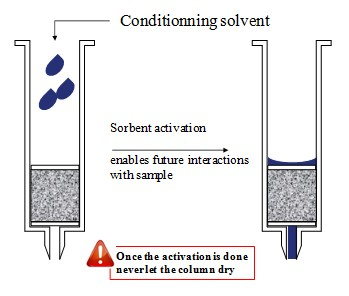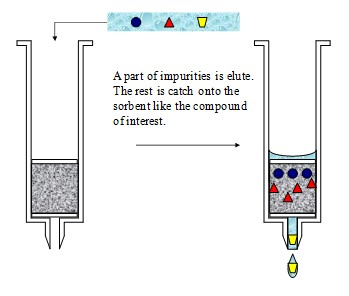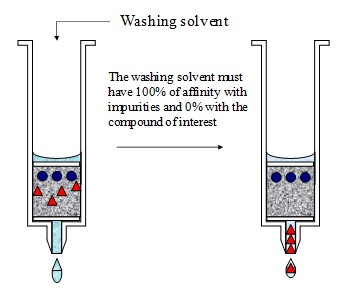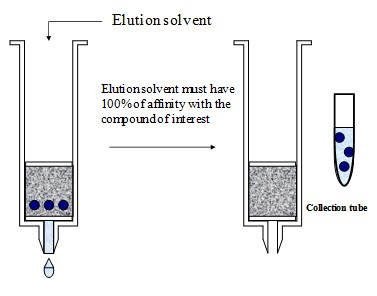1- Conditionning step
Sorbent activation and functional group activation are achieved by passing a volume of an appropriate solvent or a mixture of solvent, through the column.
Column frits are simultaneously solvated.
Methanol or acetonitrile are commonly used for activating hydrophobic sorbents, whilst hexane or dichloromethane activate hydrophilic sorbents. 2 to 4 bed volumes are typically recommended. |
 |
2- Sample Loading step
Apply sample onto the upper part of the sorbent bed. Matrix contaminants may pass through the column unretained, and additionally, other matrix components may be more or less strongly retained on the sorbent surface.
To get a maximum purification efficiency, the sample flow needs to be controlled.
To achieve faster flow of viscous sample through a column, 90 to 140 µm sorbents can be used. The exchange capacity and selectivity are unaffected.
[It is necessary to analyze the unretained fraction to check if all compounds of interest have been retained] |
 |
3-Washing step
Passing solvents through columns washes away interfering compounds whilst leaving the analyte undisturbed on the sorbent bed.
Different solvents or solvent mixtures may be used to improve the rinsing efficiency. |
 |
4- Drying step
A drying step may sometimes be necessary.
Solvent traces are evaporated by circulating air through the column over a 2 to 10 minute time period. This improves the extraction yield. |
5 - Elution step
An appropriate solvent is passed through the column to disrupt the analyte-sorbent interaction and to elute 100% of compounds of interest.
The appropriate solvent must have maximum interaction with the compound of interest and a minimal interaction with the remaining impurities, leaving them undisturbed on the sorbent bed.
In addition the volume of the elution solvent needs to be as small as possible to maximise the concentration factor.
[Sorbent with low particle size (e.g 30,50 µm) gives a lower elution volume than larger sorbent particle size (e.g 90, 140 µm)]. |
 |
6- Evaporation step
Compounds of interest are concentrated by evaporating a part of the solvent.
If necessary, dry the eluate with anhydrous sulfate to remove possible water traces.
The concentrated sample is then ready for analysis.
We recommends that all steps should be carefully optimized according to the customer specific extraction. This will improve the quality of the final analysis. |